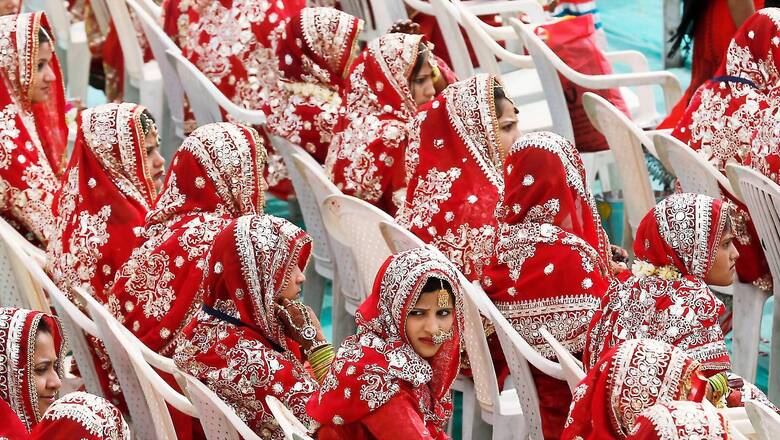
views
The Union government has taken a decision to raise the legal age of marriage for women from 18 to 21 years. With this decision, the legal age of marriage for both women and men would be 21 years. Prima facie it is a positive development and must be welcomed. However, several other conditions that restrict and control women, leading to denial of their rightful place in society, need to be addressed for this measure to really translate into women’s equality. Legal provisions alone cannot achieve much without a gender just and enabling environment at home and in society.
One of the important concerns in India has been prevalence of child marriages across ethnic and religious communities despite it being illegal. Poverty, lack of education, cultural norms and patriarchal mindsets are some of the key reasons for this. Child marriages take place in our society despite a law on prohibition of child marriages enacted in 2006. The recent National Family Health Survey (NFHS) shows that there has been 23 per cent incidence of child marriages in 2019-20. The concern about abuse of minors in marriage is real.
The government had appointed a committee headed by politician Jaya Jaitly to evaluate the feasibility of raising age of marriage and its implications on health and education opportunities for women and children. The committee obtained feedback from youth of different backgrounds and conducted a survey involving 16 universities and 15 NGOs working amongst the marginalized before arriving at the recommendation. They also recommended other affirmative measures for girls, such as easy access to education apart from raising the age of marriage.
Ours is a diverse country where different communities follow age-old norms and practices with regard to marriage. The Hindu Marriage Act 1955 stipulates 18 and 21 years as minimum age of marriage for girls and boys respectively. But it is common knowledge that child marriages take place across caste and community spectrum as highlighted by NFHS. It is not unusual to find both bride and groom to be under age in several instances in rural and urban places irrespective of economic background. The law is helpless in front of deep-seated cultural behaviour and practices.
On the other hand, puberty is the deciding factor for girls as per the uncodified Muslim Personal Law. This is deeply problematic. A girl attains puberty when she begins to menstruate. Muslim marriage is a social contract. How can an adolescent of 15 be trusted to enter into a social contract? Marriage is a serious relationship that calls for emotional maturity and other social skills that come at a certain ripe age. A child bride cannot be expected to care for herself, leave alone her children. Muslim girls should be included in legal provisions on age of marriage.
The socioeconomic condition of a family or a community can have a huge bearing on the condition of girls in that community. I would safely assume that most girls in the highly educated Christian communities would be marrying well after 21 years.
Many girls today are breaking gender and cultural barriers to fulfill their dreams to become doctors, engineers, academics, scientists and so on. But unfortunately, these opportunities are not available to crores of girls who continue to be denied their fundamental rights in our male-dominated unequal society. Preference for male child remains across communities and girls continue to be discriminated leading to malnourishment and stunted growth conditions. Access to education and particularly higher education remains restricted for girls. Cultural barriers result in mobility restrictions and denial of freedom to make important decisions. Girls continue to be viewed as “paraya dhan” and families are ever eager to marry them off at the earliest opportunity.
It is not unusual in our society to come across families where a good match in marriage is the highest objective that is pre-set in a girl’s life. As though she was born solely for the purpose of becoming a wife! In such a scenario, it becomes important to provide an enabling legal framework. A girl should be able to choose whom to marry and when to marry and not to marry at all, if she so desires.
Marriage would be the most important relationship in the life of both spouses. Naturally, consent of both parties is very important to enter into a lifelong relationship. The ability to choose a partner as also the ability to give informed consent cannot come easily to a teenager. It is important for both partners to think through before choosing to enter into marriage. Higher age of marriage can address some of these concerns.
There are concerns over raising of age of marriage to 21 on the grounds that it would lead to greater criminalization of the poor and the marginalized. The answer would be to build greater awareness and to enable weaker communities to access education and economic upliftment. For its part, the government must facilitate this. Legal reform cannot succeed without participation of all concerned. There should be sufficient impetus for social reform towards gender equality. The government must bring a comprehensive vision plan to enable girls to become empowered humans and equal citizens.
The author is co-founder of Bharatiya Muslim Mahila Andolan. The views expressed in this article are those of the author and do not represent the stand of this publication.
Read all the Latest Opinions here




















Comments
0 comment